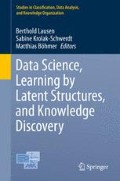Abstract
In this paper, we introduce a new approach for supervised classification to handle mixed-data (i.e., categorical, binary, and continuous) data structures using a hybrid radial basis function neural networks (HRBF-NN). HRBF-NN supervised classification combines regression trees, ridge regression, and the genetic algorithm (GA) with radial basis function (RBF) neural networks (NN) along with information complexity (ICOMP) criterion as the fitness function to carry out both classification and subset selection of best predictors which discriminate between the classes. In this manner, we reduce the dimensionality of the data and at the same time improve classification accuracy of the fitted predictive model. We apply HRBF-NN supervised classification to a real benchmark credit approval mixed-data set to classify the customers into good/bad classes for credit approval. Our results show the excellent performance of HRBF-NN method in supervised classification tasks.
Access this chapter
Tax calculation will be finalised at checkout
Purchases are for personal use only
References
Akaike, H. (1973). Information theory and an extension of the maximum likelihood principle. In B. H. Petrox & F. Csaki, (Eds.), Second International Symposium on Information Theory (pp. 267–281). Budapest: Academiai Kiado.
Akbilgic, O. (2011). Variable selection and prediction using hybrid radial basis function neural networks: A case study on stock markets. PhD thesis, Istanbul University.
Akbilgic, O., & Bozdogan, H. (2011). Predictive subset selection using regression trees and rbf neural networks hybridized with the genetic algorithm. European Journal of Pure and Applied Mathematics, 4(4), 467–485.
Akbilgic, O., Bozdogan, H., & Balaban, M. E. (2013). A novel hybrid RBF neural network model as a forecaster. Statistics and Computing. doi:10.1007/s11222-013-9375-7.
Anderson, R. (2007). The credit scoring toolkit. Oxford: Oxford University Press.
Bishop, C. M. (1991). Improving the generalization properties of radial basis function neural networks. Neural Computation, 3(4), 579–588.
Bishop, C. M. (1995). Neural networks for pattern recognition. Oxford: Oxford University Press.
Bozdogan, H. (1987). Model selection and Akaike’s information criterion (AIC): The general theory and it’s analytical extension. Journal of Mathematical Psychology, 52(3), 345–370.
Bozdogan, H. (1994). Mixture-model cluster analysis using a new informational complexity and model selection criteria. In H. Bozdogan (Ed.), Multivariate Statistical Modeling, Proceedings of the First US/Japan Conference on the Frontiers of Statistical Modeling: An Informational Approach (Vol. 2, pp. 69–113). North-Holland: Springer
Bozdogan, H. (2000). Akaike’s information criterion and recent developments in informational complexity. Journal of Mathematical Psychology, 44, 62–91.
Bozdogan, H. (2004) Intelligent statistical data mining with information complexity and genetic algorithms. In H. Bozdogan (Ed.) Statistical data mining and knowledge discovery (pp. 15–56). Boca Raton: Chapman and Hall/CRC
Breiman, L., Freidman, J., Stone, J. C., & Olsen, R. A. (1984). Classification and regression trees. Boca Raton: Chapman and Hall.
Credit Approval Data Set by UCI MAchine Learning Repository. http://archive.ics.uci.edu/ml/datasets/Credit+Approval. Cited April 26, 2013
David, W. C., & Alice, E. S. (1996). Reliability optimization of series-parallel systems using a genetic algorithm. IEEE Transactions on Reliability, 45(2), 254–266.
Eiben, A. E., & Smith, J. E. (2010). Introduction to evolutionary computing. New York: Springer.
Flach, P. A., Hernandez-Orallo, J., & Ferri, C. (2013). Comparing apples and oranges: Towards commensurate evaluation metrics in classification. Keynote lecture presented in the European Conference on Data Analysis (ECDA-2013), Luxembourg.
Hoerl, A. E., Kennard, R. W., & Baldwin, K. F. (1975). Ridge regression: Some simulations. Communications in Statistics, 4, 105–123.
Kubat, M. (1998). Decision trees can initialize radial basis function networks. Transactions on Neural Networks, 9(5), 813–821.
Kullback, A., & Leibler, R. (1951). On information and sufficiency. Annals of Mathematical Statistics, 22, 79–86.
Liu, Z., & Bozdogan, H. (2004) Improving the performance of radial basis function classification using information criteria. In H. Bozdogan (Ed.), Statistical data mining and knowledge discovery (pp. 193–216). Boca Raton: Chapman and Hall/CRC.
Orr, M. (2000). Combining regression trees and RBFs. International Journal of Neural Systems, 10(6), 453–465.
Rissanen, J. (1978). Modeling by shortest data description. Automatica, 14(5), 465–471.
Schwarz, G. (1978). Estimating the dimension of model. Annals of Statistics, 6, 461–464.
Sutton, C. D. (2005). Classification and regression trees, bagging, and boosting. In Handbook of statistics Vol. 24, pp. 303–329. Elsevier B.V. doi: 10.1016/s0169-716(04)24004-4.
Tikhonov, A. H., & Arsenin, V. Y. (1977). Solutions of ill-posed problems. New York: Wiley.
White, H. (1982). Maximum likelihood estimation of misspecified models. Econometrica, 50, 1–25.
Acknowledgements
This paper was invited as a keynote presentation by Prof. Bozdogan at the European Conference on Data Analysis (ECDA-2013) at the University of Luxembourg in Luxembourg during July 10–12, 2013. Prof. Bozdogan extents his gratitude to the conference organizers: Professors Sabine Krolak-Schwerdt, Matthias Bömer, and Berthold Lausen.
Author information
Authors and Affiliations
Corresponding author
Editor information
Editors and Affiliations
Rights and permissions
Copyright information
© 2015 Springer-Verlag Berlin Heidelberg
About this paper
Cite this paper
Akbilgic, O., Bozdogan, H. (2015). A New Supervised Classification of Credit Approval Data via the Hybridized RBF Neural Network Model Using Information Complexity. In: Lausen, B., Krolak-Schwerdt, S., Böhmer, M. (eds) Data Science, Learning by Latent Structures, and Knowledge Discovery. Studies in Classification, Data Analysis, and Knowledge Organization. Springer, Berlin, Heidelberg. https://doi.org/10.1007/978-3-662-44983-7_2
Download citation
DOI: https://doi.org/10.1007/978-3-662-44983-7_2
Publisher Name: Springer, Berlin, Heidelberg
Print ISBN: 978-3-662-44982-0
Online ISBN: 978-3-662-44983-7
eBook Packages: Mathematics and StatisticsMathematics and Statistics (R0)

